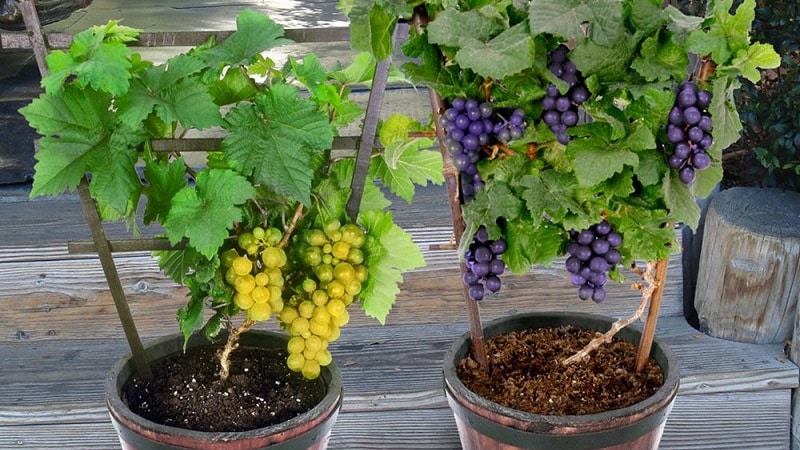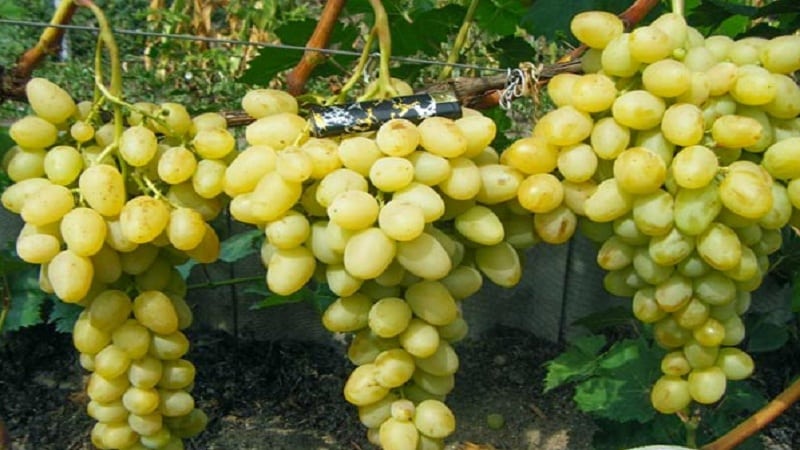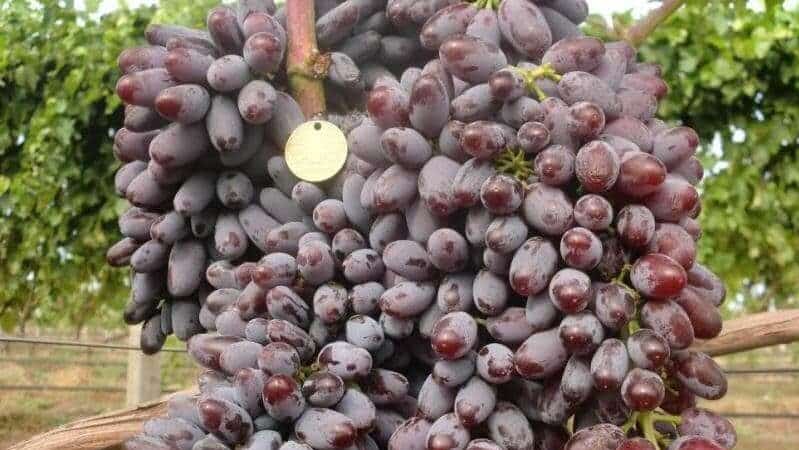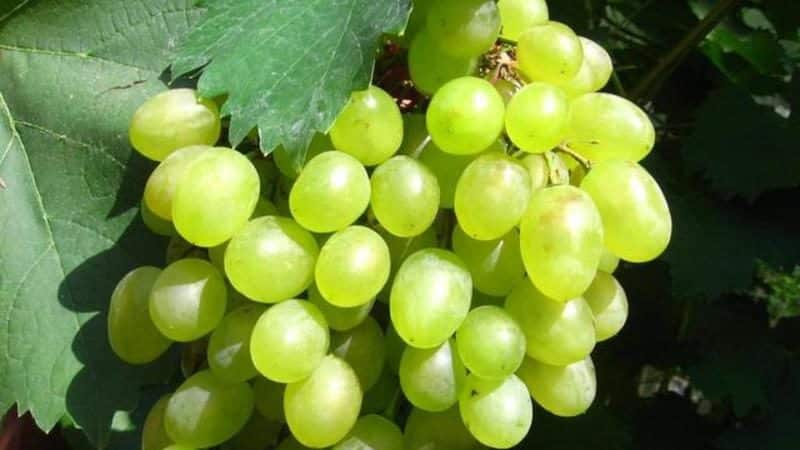Description of grape varieties for Krasnodar
Regions of the Krasnodar Territory with a temperate continental and subtropical climate are ideal for growing grapes. This culture prefers warm and sunny lands, absence of winds and drafts, fertile soil.
Table varieties are grown for fresh consumption, while technical varieties are grown for processing into wine, juice, champagne and other drinks. We offer a description of the best grape varieties for the Krasnodar region and the secrets of their cultivation.
The best table grape varieties for the Krasnodar region
Table varieties are distinguished by large fruits, thin skin, tender and sweet pulp. Growing table grapes requires compliance with agrotechnical rules - the size and quality of the fruit is affected by fertilizers, pruning and the formation of bushes. According to the ripening period, table varieties are divided into early, middle and late ripening.

Early
Early ripening varieties begin to bear fruit in July, the ripening period is 100-115 days. They are ideal for fresh consumption - the sweet pulp appeals to many people. In order for early grapes to ripen on time, it is important to follow planting rules and grow them on loose and nutritious soils, protected from gusty winds.
Arcadia

Medium-sized bushes, the vine ripens quickly. Leaves with slight pubescence on the lower part, large. The bunch is loose, conical-cylindrical in shape, average weight - 600 g. Berry length - about 3 cm, ovoid in shape, greenish-yellow in color. The skin is strong, the flesh is dense and tender.The taste is harmonious, sweetish. At the moment of full ripening, a light nutmeg aroma is felt. Arcadia is mildew resistant and suitable for transportation. Frost resistance is down to -21°C, so shelter for the winter is required.
Mascot
The bushes are medium-sized, the vines are strong and elastic, with weak pubescence. Talisman's flowers are female, so pollinating varieties are planted nearby. The bunch is conical in shape, the average weight is 700 g, but some specimens reach 2 kg. The berries are round, weigh about 12 g, amber-yellow in color with a thick waxy coating. The pulp is sweet, nutmeg, with a rich aroma.
Talisman ripens in the third decade of August, fruiting lasts 2-3 weeks. The variety is resistant to insect pests and powdery mildew; seedlings quickly adapt to the climatic conditions of the region. The application is universal: grapes are eaten fresh, processed into jam and juice, and dried for the winter.
Helios
Very early table grapes ripen in 95-105 days. The bushes are medium-sized, the leaves are large and pubescent. The flowers of the plant are bisexual, so the yield does not depend on pollinating insects and weather conditions. The weight of the bunch is about 500 g, the structure is dense, the shape is conical. The berries are pink, round-ovoid. The pulp is fleshy, nutmeg, the juice is colorless. The tasting rating of the variety is 9 points. Resistance to mildew and gray rot is high, transportability is average. Requires shelter for the winter.
Mid-season
Mid-ripening varieties ripen by early August, fruiting lasts 115-130 days. They are demanding when it comes to fertilizing - summer residents regularly fertilize grapes with superphosphate, and before planting, they pour manure or chicken droppings into the hole.

Rizamat
The bushes are tall and require a lot of free space.Gardeners annually form shoots and remove unnecessary vines - the yield and quality of the fruit depend on this. The weight of the bunch is 800-1500 g, the shape is cone-shaped. The color is pink-violet with a tan and a waxy coating. The berries are cylindrical in shape, weighing about 10 g per one. The pulp is crispy and tender, the peel is thin but durable.
Rizamat is grown in greenhouses or open ground, used for making raisins or eaten fresh. The variety is demanding in terms of growing conditions; summer residents pay special attention to fertilizing and watering - the plant does not tolerate drought and excessive humidity.
Strashensky
Strasensky grapes have average winter hardiness, so for the winter they are covered with agrofibre or thick film. The bushes are tall, the green leaves have dense pubescence. The vines are strong and powerful, dark brown in color. The weight of a cylindrical bunch is 600-900 g, the structure is loose, the stem is long. The berries are flat-round, weighing about 8 g, the skin is of medium thickness. The color is dark purple, rich, with a thick waxy coating. The pulp is dense, the taste is classic grape, pleasant. Resistance to mildew is increased, to gray rot and powdery mildew - average.
Larni Nutmeg
The bushes are slightly spreading with large dark green leaves. The clusters are loose, conical-cylindrical in shape, with a medium stem. The berries are round, slightly flattened on the sides, and have an attractive yellow-golden hue. The taste is nutmeg with a pleasant aftertaste, the weight of the berry is about 4 g. The yield of the variety is up to 5 kg of fruit per bush. Larni Muscat is valued for its product and taste qualities, ease of cultivation and versatility.
Interesting! To keep the grapes fresh, they are cut along with pieces of the vine. Inspect the fruits and remove dry or moldy ones.The brush is hung in a cool, dark place, such as an attic or crawl space. Before this, the grapes are not washed or left in the sun.
Late
Late-ripening varieties ripen in September. During cultivation, summer residents ensure that insect pests do not appear on the bushes and regularly spray the plants to protect them from diseases. Late varieties are used for sale and transportation; dense skin and waxy coating protect the grapes from cracking.
Moldova
Late-ripening table grapes from Moldova are moderately resistant to frost and are rarely affected by mildew. The clusters are loose or dense, weight - 400-600 g, conical-cylindrical shape. The weight of the oval berry is about 5 g, the peel is dense. The color is dark purple with a black tint, with a thick waxy coating. The taste is sour-sweet, refreshing, with a bright nutmeg aroma. There are 2-3 seeds in the berry. The Moldova variety is valued for its keeping quality and transportability; the berries are suitable for processing and fresh consumption. Grapes are grown not only in the Krasnodar region, but also in the Republic of Adygea and the Rostov region.
Prikubansky
Prikubansky is unpretentious in cultivation, the bushes are medium-sized and slightly spreading. The clusters are cylindrical or conical, average weight - 412 g. The berries are round, weight - 8 g, color dark purple. The taste is harmonious, sweet, and the aroma is medium. Prikubansky can withstand temperatures down to -22°C and is transportable. Tasting score: 8.6 points. Grapes are grown on loamy neutral soils; the distance between seedlings should be at least 2.5 m.
Pukhlyakovsky
The self-sterile Pukhlyakovsky variety needs pollinators, so other grape bushes are planted next to it. Universal purpose, average frost resistance, strong immunity.The clusters are compact, weigh 90 g, conical, loose. The berries are oval-ovoid, weight - about 2 g. The color is golden-white with a greenish tint, the thin skin shines through in the sun. The taste is interesting, berry-nutmeg, with a refreshing sourness. Each berry contains 1-2 seeds.
This is interesting:
Characteristics and description of early grape varieties
Technical grape varieties for the Krasnodar region

Industrial grapes are suitable for the production of wine drinks. Its external qualities are not as important as those of table varieties, the main thing is the presence of juice and dense pulp.
One of the common varieties is Muscat Odessa. It has medium-sized bushes and small dissected leaves. The ripening period is mid-early, fruiting occurs on the 130th day. The flowers are bisexual, the yield is stable. The white berries are small and spherical in shape. The clusters are conical, weight - about 200 g. The pulp is slimy, the skin is thin but strong, protects the fruit from rot and mold. The taste is harmonious grape with a strong muscat aroma. Frost resistance - down to -24°C. Odessa Muscat is used to make dry wine and champagne.
Another technical variety for the Krasnodar region is Kubanets. Late ripening, vigorous. The weight of the conical bunch is about 300 g, the color is dark blue, rich. The berries are round, the pulp is juicy and pleasant. The peel has a thick waxy coating and is dense. The variety is resistant to mildew and phylloxera, and is rarely damaged by wasps and spider mites. Table, dessert, and dry wines are prepared from Kubanets grapes.
Interesting! For planting in the Krasnodar region, cuttings with a diameter of 6-13 mm with a closed root system are chosen.If a gardener is growing grapes for the first time, it is recommended to pay attention to seedlings with bisexual flowers - you won’t have to hiccup pollinators. The appropriate time to purchase cuttings is mid-May or early June.
Conclusion
Viticulture in the Krasnodar Territory is actively developed - delicious fruits are grown not only by amateur gardeners in their plots, but also by professional agronomists in nurseries, vineyards and farms. The names of popular table grape varieties in Krasnodar are Prikubansky, Talisman, Arcadia, and technical varieties are Kubanets and Muscat Odessky. For the winter, the plants are covered with agrofibre, and with the arrival of spring they are fertilized with mineral complexes and organic matter. The fruits are eaten fresh and are also used to make the most delicious white and red wine, champagne, and juice.